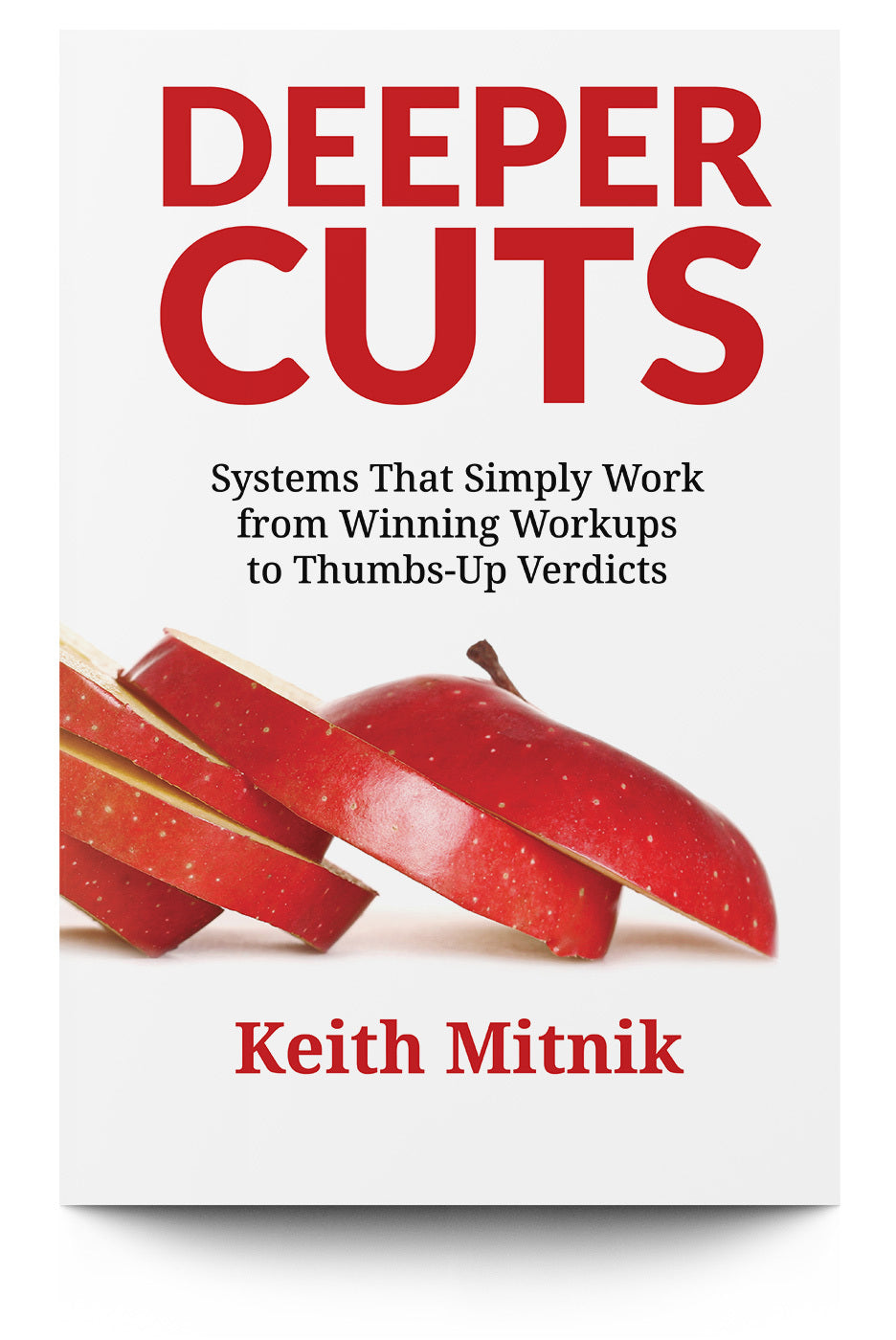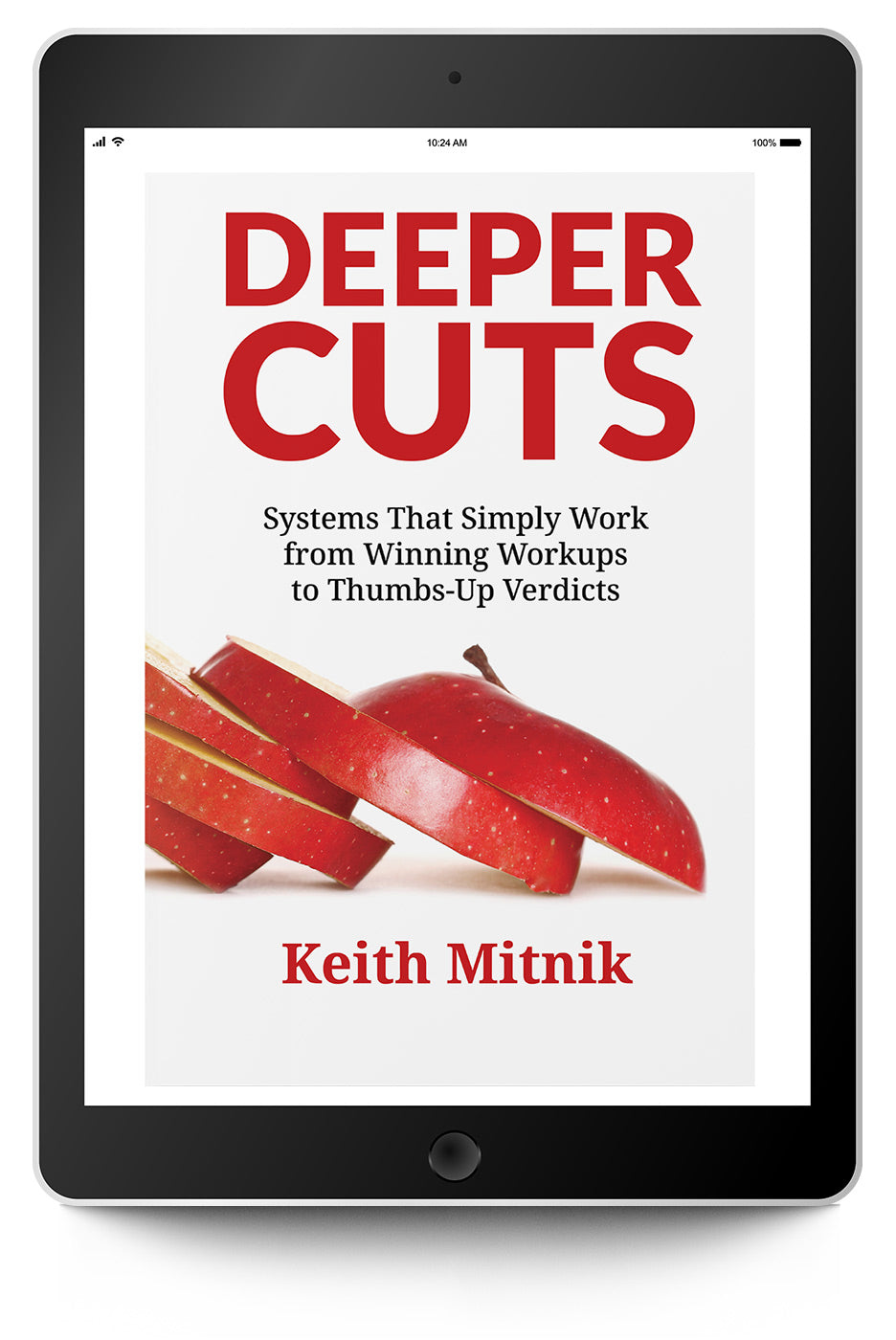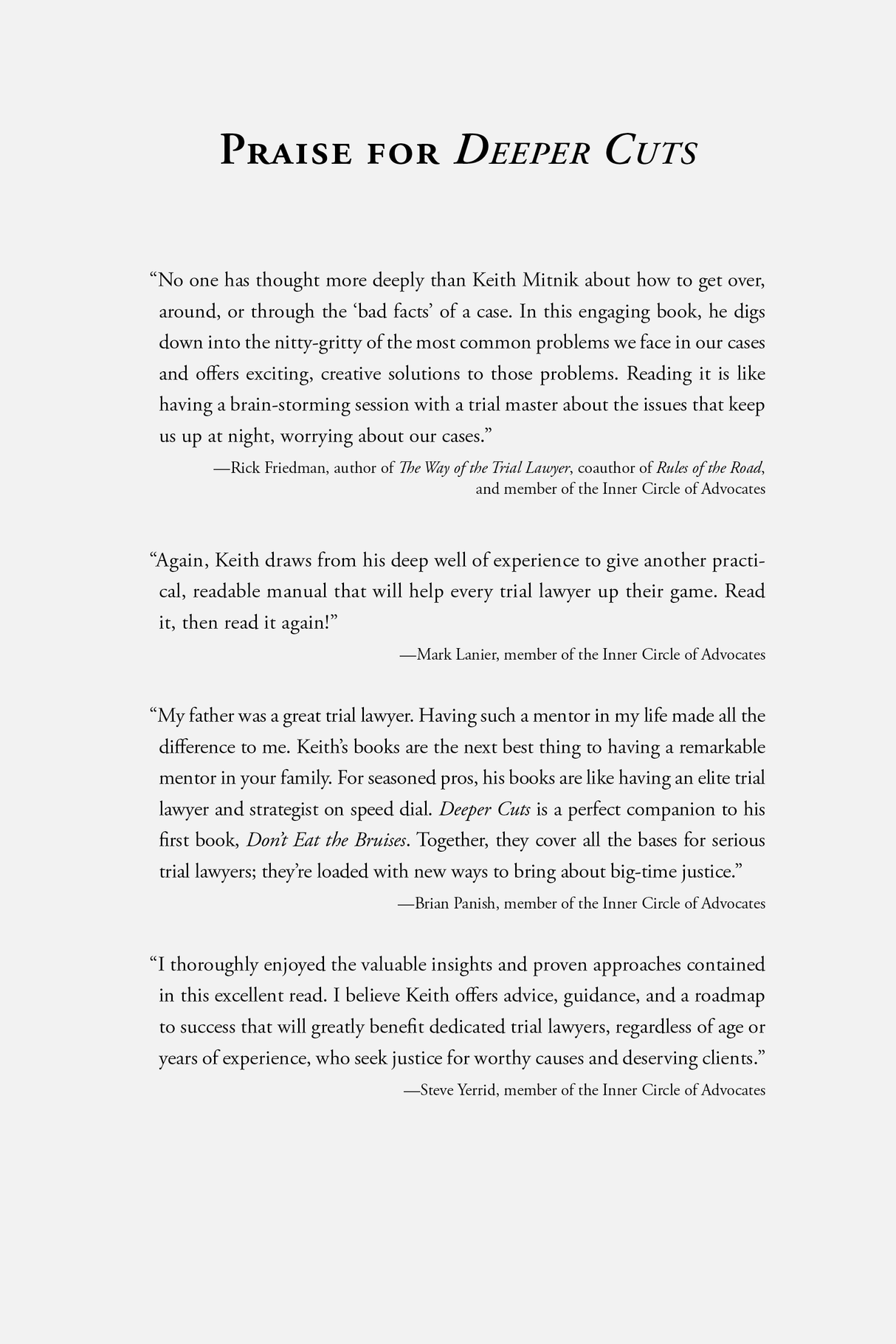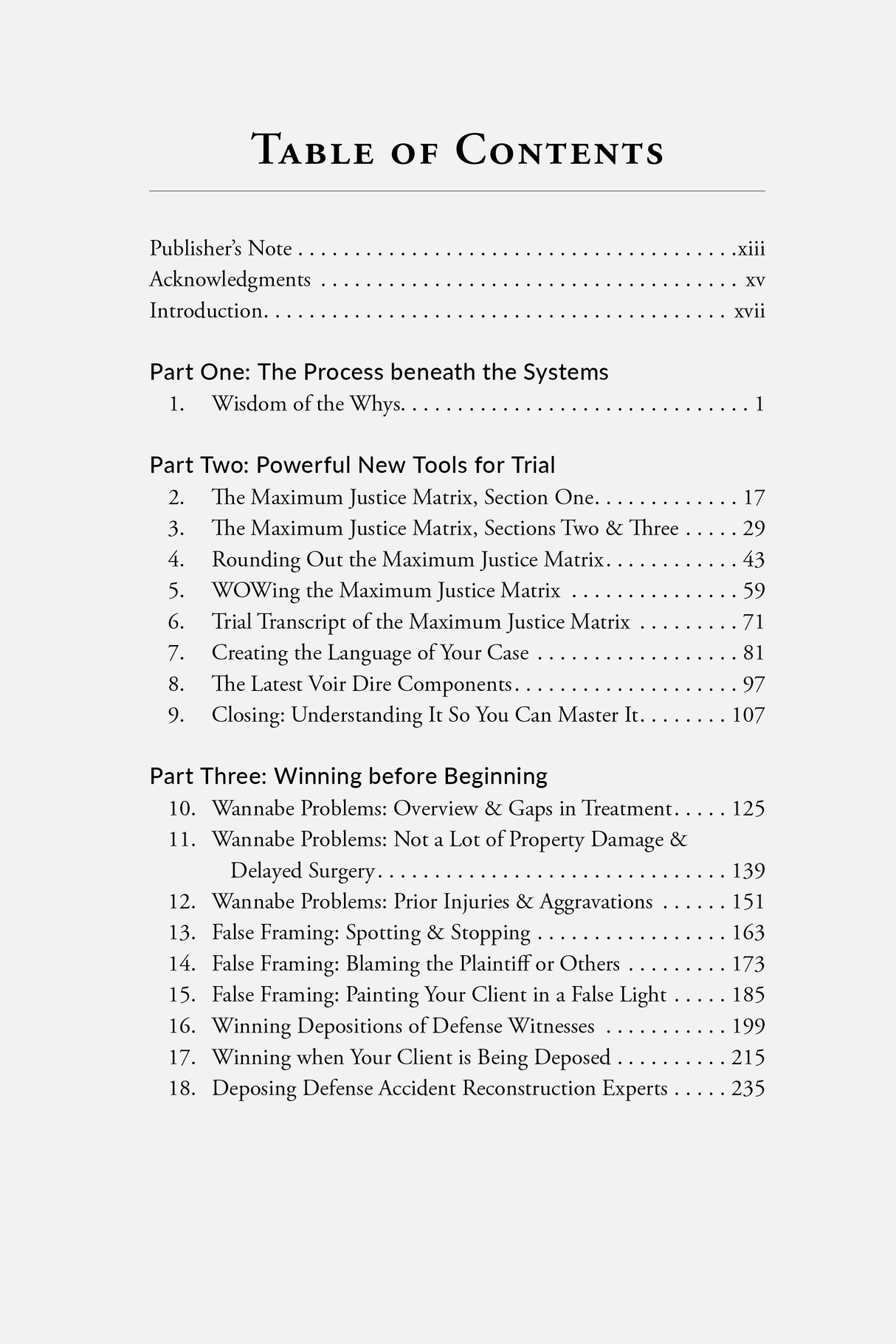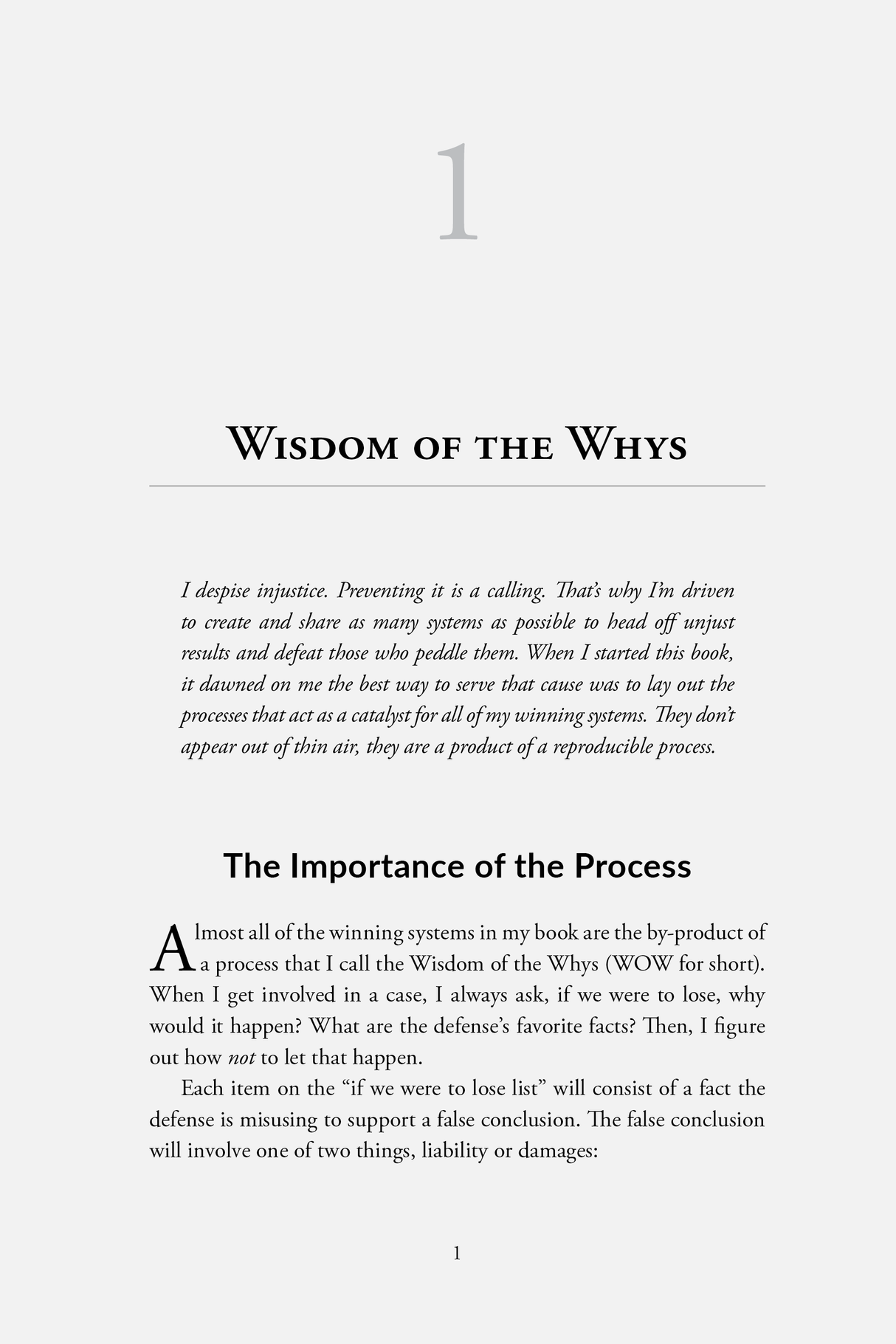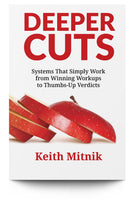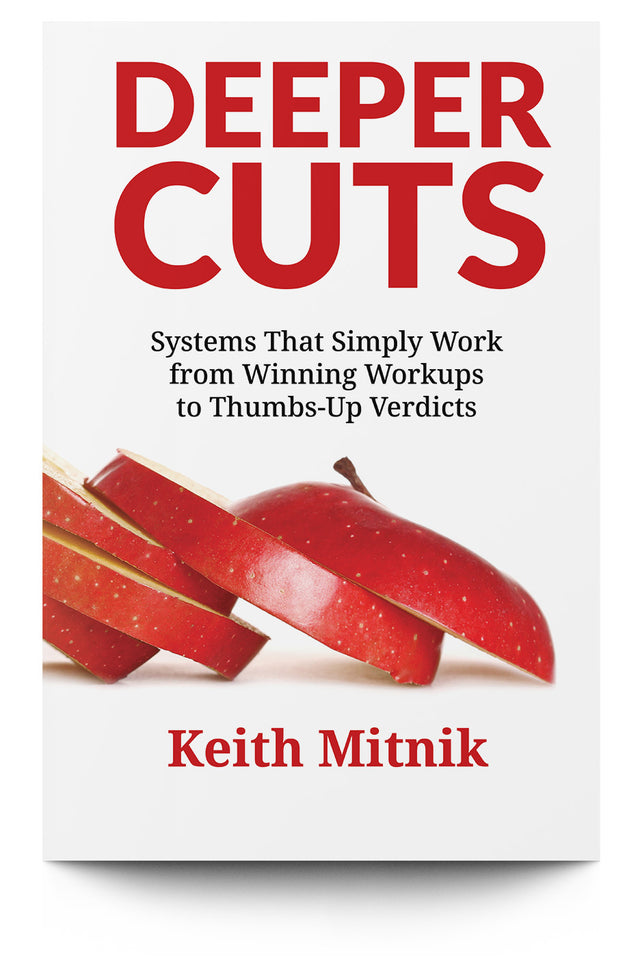Description
Description
In Deeper Cuts: Systems that Simply Work from Winning Workups to Thumbs-Up Verdicts, trial lawyer Keith Mitnik breaks down the processes he uses to try and win cases. Mitnik takes you past the strategies he teaches in Don’t Eat the Bruises and brings you behind the scenes to teach you how you can create and adapt your own winning approaches to trying a personal injury case.
Mitnik begins part one, “The Process beneath the Systems,” of the book by discussing the process he uses to create all of his strategies and approaches to trying a case, empowering you to expand Keith’s systems into new territories. Perhaps even more importantly, he also delves into why “it’s not about beings pretty” and how you can successfully try a winning case while still honing your craft.
In part two, “Powerful New Tools for Trial,” Mitnik discusses how to establish the true value of your cases where forever suffering has been thrust into your client’s life. These chapters provide a framework for damages in all kinds of cases, including steps that will put an end to defenses that belittle your client’s pain just because no one can see it. Equally important is a chapter on “Creating the Language of your Case,” where Mitnik shares a sure-fire process for finding the right words quickly and precisely to help you frame and persuasively argue your cases. Part two concludes with a focus on new strategies that can be plugged into methods from Don’t Eat the Bruises and includes pieces on medical malpractice, voir dire, opening, and closing.
Part three, “Winning before Beginning,” takes a step back and focuses on case preparation. Mitnik shows how many of the problems you think you have in your cases aren’t actually problems—just matters of framing and perspective. The chapters on “wannabe problems” will systematically prove to you that many of the concerns in car crash, herniated disc cases—such as priors, not going to the doctor right away, putting off surgery, not a lot of visible property damage, and treatment gaps—are simply not reasons to see your case as compromised or to shun taking it to trial. Mitnik shows you how cases with those typical facts are often really good cases, worthy of your commitment. In the chapters on false framing, you will see how to spot and stop universal defense strategies to make your cases look like a mess when they are good cases that deserve full justice, and your full attention. This part of the book ends with a focus on depositions, where cases are often won or lost. Mitnik lays out systems and deposition checklists to make sure you win the case preparation “workup wars,” and as he puts it, “have a blast in the process.”
Part four of the book, “Medical Malpractice—Breaking Down Barriers,” addresses how to try some of the most difficult cases a plaintiff’s lawyer can take on: medical malpractice. Here, Mitnik discusses the unique issues these cases present and divides them into four categories:
- The bias/sympathy barrier
- The standard of care nightmare
- The not so good Samaritan
- The medical maze hiding place
Mitnik then devotes the rest of part four to teaching you counterstrategies to knock down every one of these issues that prevent just results for your clients.
Lastly, part five, “Silver Linings,” is on trials in a post-COVID world. Here, Mitnik looks to past circumstances where there have been reasons for jurors to turn their backs on individual suffering to guide his opinions about what he expects will happen. He argues that plaintiff’s lawyers may need to take new approaches in jury selection or make adjustments to how they frame cases, and he offers insights and examples from different trials to demonstrate how to look for common ground and themes going forward.
From bias-busting systems for voir dire, new ways to get maximum value on your cases, illustrative case examples, and winning case preparation strategies, this is not a book you want to miss.
Your eBooks are now accessible from your Trial Guides account! Click here for step by step instructions.
Do you want the eBook and print book? After you complete your purchase of the print book you will receive a coupon code via email to purchase the eBook for $20.
Author
Author
Details
Details
Paperback: 352 pages; 1st edition (2021); ISBN: 978-1-951962-15-9
Publisher: Trial Guides, LLC
Table of Contents
Table of Contents
Acknowledgments
Publisher’s Note
Introduction
Part One: The Process beneath the Systems
- Wisdom of the Whys
Part Two: Powerful New Tools for Trial
- The Maximum Justice Matrix, Section One
- The Maximum Justice Matrix, Sections Two and Three
- Rounding Out the Maximum Justice Matrix
- WOWing the Maximum Justice Matrix
- Trial Transcript of the Maximum Justice Matrix
- Creating the Language of Your Case
- The Latest Voir Dire Components
- Closing: Understanding It So You Can Master It
Part Three: Winning before Beginning
- Wannabe Problems: Overview and Gaps in Treatment
- Wannabe Problems: Low Damages and Delayed Surgery
- Wannabe Problems: Prior Injuries and Aggravations
- False Framing: Spotting and Stopping
- False Framing: Blaming the Plaintiff or Others
- False Framing: Painting Your Client in a False Light
- Winning Depositions of Defense Witnesses
- Winning when Your Client is Being Deposed
- Deposing Defense Accident Reconstruction Experts
Part Four: Medical Malpractice: Knocking Down Barriers
- Potholes and the Path to Justice
- The Standard of Care Nightmare
- Putting an End to Pretending and Hiding
Part Five: Silver Lining
- Thoughts on Trials in the Times of COVID
- Guiding Lights: Three Trials
Conclusion
Free Chapter Sample
Free Chapter Sample
What Legal Leaders Are Saying
— Steve Yerrid, member of the Inner Circle of Advocates“I thoroughly enjoyed the valuable insights and proven approaches contained in this excellent read. I believe Keith offers advice, guidance, and a roadmap to success that will greatly benefit dedicated trial lawyers, regardless of age or years of experience, who seek justice for worthy causes and deserving clients.”
— Lisa Blue, PhD, trial lawyer and consultant, past president of the AAJ and coauthor of The Little Blue Books“Keith Mitnik is a genius. I am a huge fan and recommend this book highly to anyone who steps in a courtroom. After reading this book, you’ll understand why Keith is one of the most successful trial lawyers in America.”
— John Edwards, former US Senator and member of the Inner Circle of Advocates“Keith Mitnik is one of the greatest trial lawyers in America. And he has a unique ability to share the specific concepts and techniques that make him great. I love to pick his brain about challenging cases I have. Deeper Cuts, which seamlessly flows from Keith’s first book, Don’t Eat the Bruises, must be read by any serious trial lawyer.”
— David Ball, PhD, trial consultant and author of David Ball on Damages“Deeper Cuts is Keith Mitnik's new companion book to his amazing toolbox of advocacy treasures, Don't Eat the Bruises. Keith walks you through the most important matters you need to handle, why to handle them, and exactly how—right down to the very words to say. Practical and uncommonly wise, Deeper Cuts’ methods will interlock with whatever your favorite kinds of advocacy approaches are. You'll make Deeper Cuts one of your select handful of constant companions from intake through closing. Read it before accepting your next case, and certainly before your next deposition.”
— Don Keenan, coauthor of Reptile: The 2009 Manual of the Plaintiffs' Revolution“Keith Mitnik has a reputation as being an out of-the box lawyer. His new book builds on that. The format is one of the best user-friendly trial books around. It covers initial case acceptance all the way up to appeal, and it's easy to find his nuggets. For me, I found the in-depth discussion of damages and new tools to be the best. Also I liked the section on fake framing. No matter what your status as a trial lawyer, you must always continue to learn, and Keith has provided a new library.”
— Geoff Fieger, has obtained over 165 verdicts and settlements of over $1 million“So, you want to be a trial lawyer? You get yourself a degree and a suit of clothes. You get yourself a case. Now what? Well, for starters, pick up Keith's new book. Read his first one too. Then, get yourself a mirror and look into it. Long and hard. Look into your soul—just like Keith does. Never stop looking. Never stop learning. Never stop caring. And never stop trying to think like you used to, before you were a trial lawyer.”
— Tim Semelroth, past president of the Iowa Justice Association and member of the International Society of Barristers and Million Dollar Advocates Forum“During the pandemic, some people started baking bread. Keith Mitnik used his time to cook up something much more powerful. It seemed like every week Keith created a new webinar or email outlining a new trial strategy or philosophy. I am happy to report that it was time well spent. When I tried my first post-pandemic trial using Keith’s newest damage arguments, the jury came back with a verdict that was 24 times the final settlement offer! The good news is Keith’s new book, Deeper Cuts, harnesses all of that pandemic-inspired power and a whole lot more!”
— Roger Dodd, coauthor of Cross-Examination: Science and Technique, listed in Super Lawyers for both Georgia and Florida“The title of this book is right. This is a deeper drill down. I judge all legal writing in two ways: will it make me better and how long will that take? The answer for this book is, yes, and now. Keith is an enthusiastic trial lawyer. People see that, but more importantly, he is a systematic trial lawyer. He understands that trials are not a battle of facts, but a battle of conclusions formed from the facts. I won’t tell you that you are short-sighted not to read this book. But you are.”
— Scott Schlesinger, member of the Inner Circle of Advocates“Keith Mitnik is a trial lawyer's trial lawyer, admired for his painstaking attention to crafting language that resonates with juries. Deeper Cuts is both equal parts inspiration and battle-tested strategies for us trial lawyers who have been waiting over a year to get back in front of a jury.”
— Christian D. Searcy, member of the Inner Circle of Advocates, National Trial Lawyers Association Hall of Fame recipient, and former president of the Florida Justice Association“Keith Mitnik's new book, Deeper Cuts, is a great read for all trial lawyers handling personal injury and wrongful death litigation. It is filled with easy-to-read tips and methods for successfully handling these cases. It is a good primer for lawyers in their first decade of trial work. And it is a great refresher for very experienced trial lawyers. It’s filled with great techniques, dynamic concepts, and methods to add to our playbooks. I highly recommend it.”
— Russ Herman, lead trial counsel in Scott v American Tobacco, et al. ($591 million verdict), recipient of The Leonard M. Ring Champion of Justice Award, and past president of the American Association for Justice and the Roscoe Pound Foundation“Keith Mitnik is one of the most experienced and successful trial lawyers in the country, as well as lead courtroom advocate with the largest plaintiffs’ firm in the nation, Morgan and Morgan. He has the passion, intellect, and tenacity to try every type of case as a winner. I was particularly interested in the chapter on malpractice (for me, the most difficult for trial prep and jury trials.) One has to have studied problems to deal effectively with them. Keith’s superb treatment for defining problems and solutions is outstanding, as is the entire text. Deeper Cuts is a must have for any trial lawyer who seeks justice in any case.”
— Rick Friedman, author of The Way of the Trial Lawyer, coauthor of Rules of the Road, and member of the Inner Circle of Advocates“No one has thought more deeply than Keith Mitnik about how to get over, around, or through the ‘bad facts’ of a case. In this engaging book, he digs down into the nitty-gritty of the most common problems we face in our cases and offers exciting, creative solutions to those problems. Reading it is like having a brain-storming session with a trial master about the issues that keep us up at night worrying about our cases.”
— Sari de la Motte, trial consultant and author of From Hostage to Hero: Captivate the Jury by Setting Them Free“Keith Mitnik isn’t only a terrific writer, he’s a fabulous human being who cares not just for his clients but for his fellow trial lawyers. His new book is a testament to this fact. Instead of keeping his years of knowledge and experience to himself, he freely shares what he has learned along the way so other lawyers can benefit. What I particularly love about Keith’s new book is that, in his own words, he has forged these systems to provide more ‘confidence, happiness, and fulfillment.’ Keith sees the real need here; that trial lawyers not only strive to hone their craft but do so in a way that allows them to live fulfilling lives. Bravo!”
— Mark Lanier, member of the Inner Circle of Advocates“Again, Keith draws from his deep well of experience to give another practical, readable manual that will help every trial lawyer up their game. Read it, then read it again!”
— John Romano, past president of the Academy of Florida Trial Lawyers, the Southern Trial Lawyers Association, and the National Trial Lawyers Association“Reading and studying Keith’s first book, Don’t Eat the Bruises, was a game-changer for any serious advocate. Yet the journey through Keith’s new book, Deeper Cuts—well, it’s beyond a paradigm shift for any reader’s practice of law. And I mean it! Deeper Cuts is the most comprehensive tour-guide on how to win personal injury cases. It is a step-by-step navigational tool teaching and instructing every aspect of the tactics, strategy, and methodology of how to prepare for and successfully execute at every stage. This groundbreaking book will teach you how to develop a case, master discovery techniques, and how to prepare for trial in ways you never imagined. This book is also loaded with word-and-phrase examples. It is simply the most spectacular trial-winning publication ever conceived! Every young or new plaintiffs’ lawyer must read it. Seasoned veteran advocates (including me)—you must read and study it.”
— Nicholas Rowley, coauthor of Trial by Human and Voir Dire and Opening Statement“This book, by a fellow trial lawyer who I continue to learn so much from and look up to, is a gift as gold as golden gets. Readers will not only learn how to beat every-day frivolous defenses, but, more importantly, will be given the tools needed to think and feel differently. Imagine a book that helps you find courage and learn how to reframe what you have feared, and which provides you with tools to successfully deal with defenses you have faced over and over again. Imagine learning how to take those defenses that have hurt you in the past and be able to flip them on your opponents and make your cases better. From case preparation to jury selection and the presentation of evidence to closing argument, Deeper Cuts is my new favorite. Wow! And thank you, Mr. Mitnik!”
— Courtney Rowley, coauthor of Trial by Woman and Voir Dire and Opening Statement“Keith Mitnik’s clear and comprehensive guide is both a manifesto and a practicum in how to unlock and win even your toughest case. This is the book you will be dog-earring and revisiting on every case, no matter where you are in your practice or how many cases you’ve tried—it’s like having one of the most prolific and talented (and fantastically fun) trial lawyers of our time sitting right next to you. His mastery of rhetoric and his flashlight words have changed how Nick and I think about and try our cases. Deeper Cuts holds nothing back—this book will not only help you get full justice for the people you represent, but also restore dignity to our profession as a whole.”
— Brian Panish, member of the Inner Circle of Advocates“My father was a great trial lawyer. Having such a mentor in my life made all the difference to me. Keith’s books are the next best thing to having a remarkable mentor in your family. For seasoned pros, his books are like having an elite trial lawyer and strategist on speed dial. Deeper Cuts is a perfect companion to his first book, Don’t Eat the Bruises. Together, they cover all the bases for serious trial lawyers; they’re loaded with new ways to bring about big-time justice.”
— Randi McGinn, a member of the Inner Circle of Advocates and author of Changing Laws, Saving Lives“What is the difference between a good lawyer and a great lawyer? The great lawyer has found a way to quiet doubt and fear and fight for maximum justice. In Deeper Cuts, a truly great lawyer, Keith Mitnik, teaches you how to silence the internal and external voices of uncertainty and find the audacity to ask a jury for the full value of what was taken from your client. Whether you have a small case or a large case with forever injuries, the concrete examples and arguments in this book will give you the tools you need to become a great lawyer.”
— John Morgan, founder of Morgan and Morgan“I have had a front row seat to view the genius of Keith Mitnik for many years now. His methods and strategies are part of our firm’s DNA. The verdicts that we have had all emanate from his teachings and that has allowed us to become the largest injury firm in the history of the world. If Keith had not been with me, we would not be who we are. He is giving, and now gives to our fellow trial warriors what he has given to us.”

